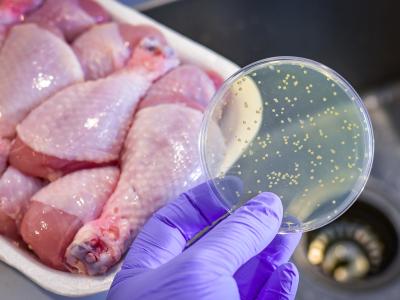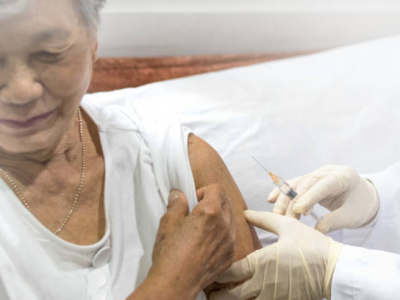Investigative report finds widespread colistin use in Indian poultry
A new story by the UK-based Bureau of Investigative Journalism alleges the last-resort antibiotic colistin is being widely used on Indian poultry farms, despite worldwide concerns that using the drug in food-producing animals could render it ineffective.
According to the story, India is importing at least 150 tons of colistin each year, and at least five animal pharmaceutical companies in India are openly advertising products containing colistin as growth promoters.
Colistin resistance emerged as a global concern in 2015, when scientists discovered the colistin resistance gene MCR-1 in Escherichia coli bacteria isolated from pigs, pork products, and humans in China. Since then the gene, which is located on mobile pieces of DNA called plasmids and can be transferred within and between different bacterial species, has spread around the globe in animals and humans. Public health officials fear that when already multidrug-resistant bacteria acquire MCR-1, untreatable infections could result.
"Colistin is the last line of defense," Timothy Walsh, PhD, an antibiotic resistance expert at Cardiff University who was a member of the team that discovered MCR-1, told the Bureau of Investigative Journalism. "It is the only drug we have left to treat critically ill patients with a carbapenem-resistant infection. Giving to chickens as feed is crazy."
The emergence of MCR-1 has been linked to widespread use of colistin on Chinese farms, and in 2016 China announced that it would no longer allow use of the drug in food-producing animals. While many countries have banned use of colistin as a growth promoter, it is still used for disease prevention. In November 2017, the World Health Organization recommended restrictions on the use of medically important antibiotics like colistin in food-producing animals, including a ban on their use for growth promotion.
Jan 30 Bureau of Investigative Journalism story
FAO official calls Southeast Asia a 'hot spot' for AMR
Widespread misuse of antibiotics in food production in Southeast Asia could magnify the threat of antimicrobial resistance (AMR) in the region, an official with the Food and Agriculture Organization (FAO) told Reuters yesterday.
FAO Chief Veterinary Officer Juan Lubroth told the news service that intense food and agriculture production, combined with high population growth, in Southeast Asia's megacities could create increased risks for drug-resistant bacterial infections in humans.
"Here in Southeast Asia…we would consider it a hotspot because of the population growth, urbanization dynamics, the production of food," Lubroth said.
The comments were made on the sidelines of a meeting in Bangkok of the Interagency Coordination Group on Antimicrobial Resistance, a body formed to guide countries in the creation of national AMR action plans and ensure sustained global action against the AMR threat.
Lubroth said the FAO advocates educating farmers about the dangers of using medically important antibiotics to promote growth in food animals, and wants stronger enforcement of rules governing food production.
Jan 31 Reuters story
Contaminated ice machines could spread microbes, researchers say
Ice machines in healthcare facilities are often contaminated with gram-negative bacilli and Candida species and are a potential source of dispersal for these organisms, researchers reported yesterday in Infection Control and Hospital Epidemiology.
In a two-part study conducted at 5 hospitals and 2 nursing homes in northeast Ohio, researchers took swab samples from 64 ice machines. In visual assessments prior to culture collection, many of these machines had stagnant water in the drain pan, had drain pans with visible grime and a layer of slime, and showed visible water dispersal onto surrounding countertops or the floor.
Gram-negative bacilli and/or Candida spp were recovered from 100% of drain pans, 52% of ice chutes, and 72% of drain-pan grilles. Of the 91 colonies of bacilli further analyzed, 55 (60.4%) were Enterobacteriaceae, and 7 isolates were resistant to carbapenems, including single isolates of Klebsiella pneumoniae, Acinetobacter baumannii, and Enterobacter cloacae.
In the second part of the study, the researchers investigated potential mechanisms of microbial dispersal by observing how the machines were used and conducting simulations in five of the machines using a fluorescent lotion to trace the path of microbes. This revealed that ice frequently fell through the drain pan grille and melted in the drain pan, resulting in stagnant, contaminated water; when more ice cubes fell through the grille into the contaminated water, the splattering dispersed microbes to the hands of users, cups, and the drain pan grille. They also found that contamination of the ice chute could result in contamination of ice cubes exiting the chute.
"Effective strategies to prevent the dispersal of microorganisms contaminating ice machines need to be developed," the authors conclude. "Regularly scheduled cleaning of ice machines has been recommended and may be beneficial in reducing the burden of microbes such that dispersal is reduced."
Jan 31 Infect Control Hosp Epidemiol abstract















